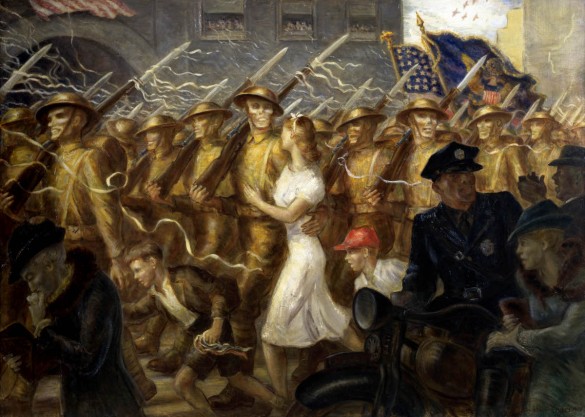
#1 John Steuart Curry (American, 1897 – 1946), Parade to War, Allegory, 1938, oil on canvas, 47 13/16 x 63 13/16 in., Gift of Barnett Banks, Inc., AG.1991.4.1.
John Steuart Curry enrolled in classes at the Kansas City Art Institute while still a junior in high school in rural Kansas. Initially he earned a living illustrating popular stories of the Wild West. Curry entered the most productive and successful period of his career in the 1930s. He taught at Cooper Union and the Art Students League in New York. He also received mural commissions as part of the Federal Art Project, which employed artists after the Great Depression. Curry’s public mural projects concentrated on themes of religious intolerance, racial discrimination, and social upheaval. In 1936 he was appointed artist-in-residence within the College of Agriculture at the University of Wisconsin, a post he held until his death. Curry is identified with the Regionalist movement through his depictions of the history, people, and landscape of the American Midwest.
Parade to War, Allegory was painted in the wake of the Great Depression and on the eve of World War II (1939-1945). Curry turns the pageantry of a parade into a scene of foreboding and dread, most obviously disclosed in the skeletal faces of the young soldiers. The panic and sorrow of the two women in the foreground contrast with the hopeful innocence of the central striding couple and the young boys gathering streamers. Typical of Curry’s work, this painting represents the isolationist attitudes and growing disillusionment expressed by an increasing number of Americans in the late 1930s.
“This painting continues to affect me every time I see it. It feels like a foreboding dream to me; it moves and haunts with the anticipation of the soldiers and the little boys versus the mourning of the woman in black and the policeman restraining the crowd.” – anonymous



[…] show. Curry was an American regionalist best known for scenes set in his native rural Kansas. But “Parade to War, Allegory” is different from […]
[…] show. Curry was an American regionalist best known for scenes set in his native rural Kansas. But “Parade to War, Allegory” is different from […]
Loved this article. Wish I could see the exhibit and more regional art from this period.
[…] show. Curry was an American regionalist best known for scenes set in his native rural Kansas. But “Parade to War, Allegory” is different from […]
Thank you for making this image available to the public. We need it as a society, particularly now. Best wishes.